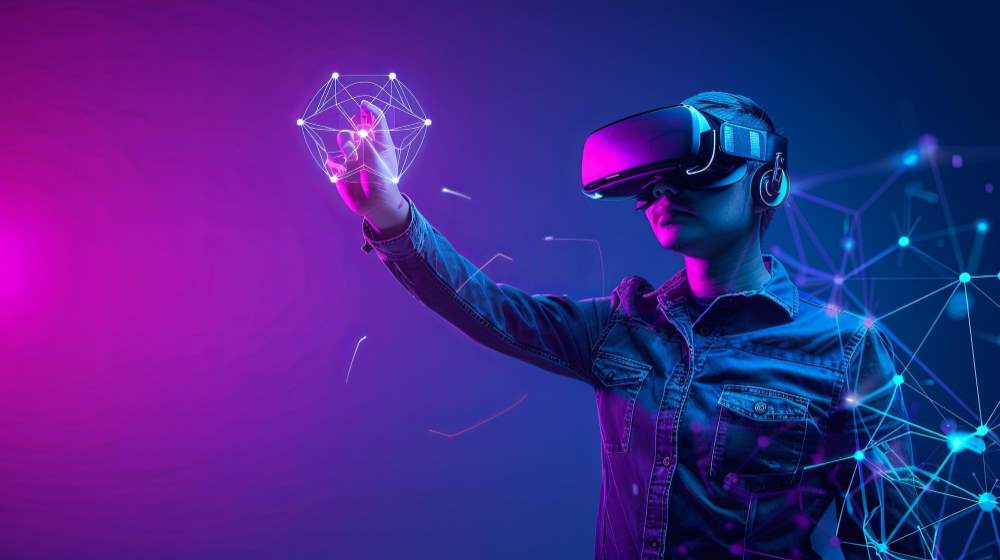1. Virtual Reality: Immersive Storytelling and Social Experiences
Virtual Reality (VR) has moved from the fringes of gaming to mainstream entertainment, offering an entirely new way to engage with content. Unlike traditional media, which is largely passive, VR places the viewer inside the story, allowing them to become active participants.
- VR Films and Series: Platforms like Oculus and HTC Vive have enabled creators to craft immersive films and narratives where viewers can explore a 360-degree environment. Instead of merely watching a film, audiences can look around, interact with elements, and even influence how the story unfolds. This form of immersive storytelling is revolutionizing how we think about visual media.
- Live Events and Concerts: Virtual concerts and live events are becoming more popular, especially after the success of events like Travis Scott’s concert in *Fortnite*. Through VR, audiences can feel like they're attending events in real time, whether it's a concert, sports match, or theater performance, all from the comfort of their home. Platforms like Wave and Sansar are pioneering this space.
- Social VR: Virtual reality isn’t just about solitary experiences. Social VR platforms like Facebook’s Horizon and VRChat allow users to hang out in virtual spaces, play games, and even watch movies together in a shared virtual environment. This blending of social interaction and media consumption is changing how we experience entertainment socially.
2. AI: Personalized and Interactive Content
Artificial Intelligence (AI) is another transformative force in the media industry, driving personalization, content generation, and interactive media experiences.
- Personalized Streaming: AI-powered algorithms are already widely used by streaming services like Netflix, Hulu, and YouTube to recommend content based on viewing habits. However, AI's capabilities are growing, enabling platforms to offer hyper-personalized content curation based on mood, time of day, and even social media trends. This kind of tailored media experience keeps users more engaged and maximizes their interaction with the platform.
- Interactive Content: AI is also enabling interactive media experiences, where the viewer can influence the storyline. Netflix’s *Black Mirror: Bandersnatch* is a well-known example, offering users multiple pathways through the story. With AI, these interactive experiences are becoming more dynamic and responsive, adapting in real time to viewer choices and preferences. Future interactive films and series could evolve based on live feedback, creating unique experiences for each user.
- AI-Generated Content: AI is beginning to generate its own content as well. Deep learning algorithms are now capable of creating music, art, and even video clips. For example, AI-generated actors or deepfake technology can place real people into fictional settings, opening up new possibilities for filmmakers.
3. Cloud Gaming: Redefining the Gaming Industry
Cloud gaming is another technology that’s poised to revolutionize media consumption, particularly in the gaming sector. By removing the need for powerful hardware, cloud gaming allows players to stream games directly from the cloud, much like Netflix streams movies.
- Gaming Without Hardware Limitations: Cloud gaming platforms like Google Stadia, Xbox Cloud Gaming, and NVIDIA GeForce Now allow users to play high-quality games on any device with an internet connection. This eliminates the need for expensive consoles or gaming PCs, making high-end gaming accessible to a wider audience. As internet speeds and cloud infrastructure improve, this model could become the standard for gaming, similar to how streaming services have taken over traditional media consumption.
- Interactive Streaming: Cloud gaming also has the potential to merge with live streaming platforms. Twitch and YouTube Gaming are already experimenting with interactive features, where viewers can influence the game being played by streamers. With cloud gaming, this could evolve into full-on interactive experiences, where viewers can jump into a game or control parts of it in real-time. The line between gamer and viewer blurs in this scenario, creating a more participatory form of entertainment.
- Cross-Platform Integration: As cloud gaming evolves, expect deeper integration with other media forms. For instance, games could be tied directly into streaming platforms, where users can watch a series and immediately play a related game within the same ecosystem. We’re already seeing hints of this with platforms like Amazon’s Luna, which offers both gaming and video streaming services.
4. Streaming Evolution: From Passive to Active Engagement
While streaming continues to dominate media consumption, the industry is also evolving beyond traditional on-demand content. The fusion of streaming with other technologies like VR and AI is creating more active engagement opportunities.
- VR Streaming: With the advent of 5G and advancements in VR hardware, streaming in virtual environments is becoming more viable. Users can watch content in a VR theater or dive into immersive worlds where the lines between film, game, and social interaction blur. Imagine watching a *Star Wars* movie in VR, where you can look around a scene or walk through it as it plays out.
- Live Interactive Shows: Platforms like Twitch and YouTube have already created live, interactive shows where viewers can influence the outcome. Whether it’s reality TV, game shows, or even fictional series, audiences are no longer passive spectators but active participants in shaping the content.
5. The Metaverse: The Ultimate Fusion of Media and Interaction
One of the most intriguing developments is the rise of the metaverse—an interconnected virtual world where users can engage in various activities, including media consumption. In the metaverse, people can socialize, work, play games, and even attend live events. This could be the future of how we consume and interact with media.
- Media Hubs in Virtual Worlds: Platforms like Decentraland and The Sandbox allow users to explore virtual worlds where they can watch movies, attend concerts, or browse digital art galleries. The idea is that in the metaverse, entertainment becomes more than just something to watch—it’s something to experience and engage with.
- Content Creation in the Metaverse: The metaverse also offers new opportunities for creators. Content can be dynamic and ever-evolving, where creators can build entire worlds, characters, and stories that users can interact with in real time. This opens up limitless possibilities for storytelling and media creation.
Conclusion
The future of entertainment is poised for a revolutionary shift, with VR, AI, and cloud gaming leading the charge. These technologies are not only enhancing media consumption but also turning it into an immersive, interactive, and personalized experience. As these trends continue to evolve, they will likely converge, creating new forms of entertainment where viewers and players are no longer passive consumers but active participants in the media they engage with.

